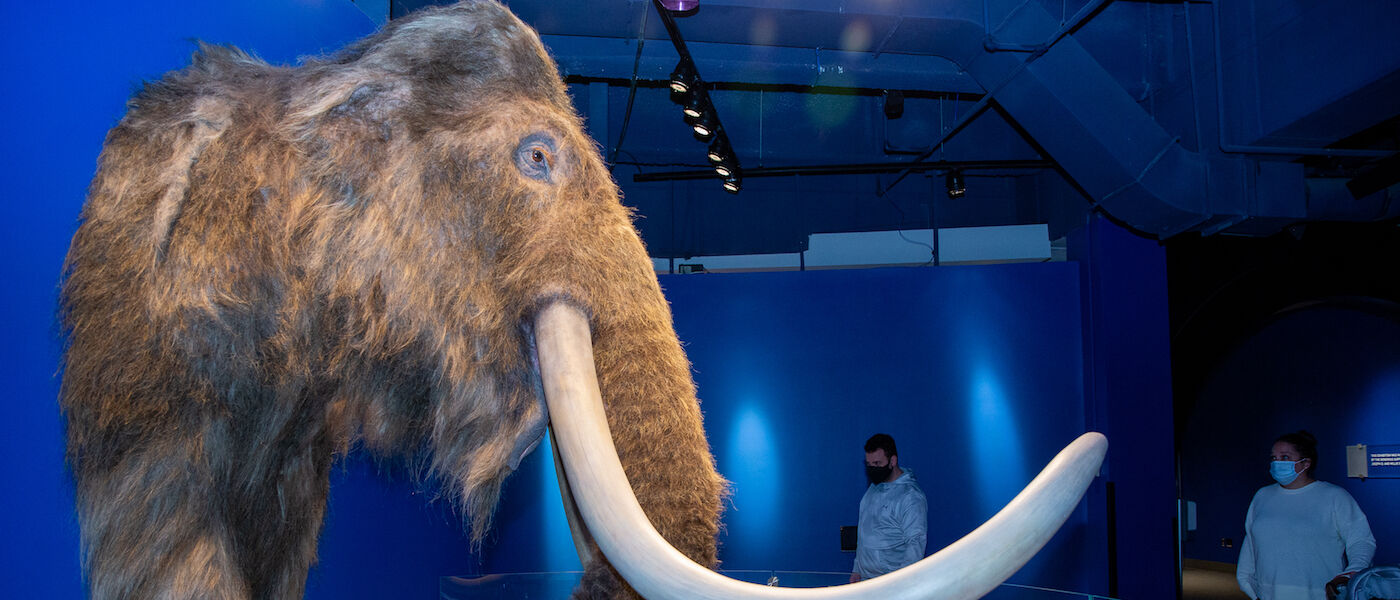Liberty Science Center Opens "Making Mammoths" Exhibit On A Harvard Geneticist's Extraordinary De-Extinction Effort to Bring Back Shaggy, Cold-Loving Elephants
JERSEY CITY, N.J., November 21, 2020 – Woolly mammoths, like dinosaurs, have long been a fascination of children of all ages. These ancient hirsute relatives of modern elephants roamed the Earth in the early days of man, giving them the special distinction of being large, charismatic creatures that, unlike dinosaurs, coexisted with humans. As such, they serve as an appealing bridge from the prehistoric to the modern.
A lifelike model of a huge woolly mammoth is being unveiled on Saturday, November 21 at Liberty Science Center as part of the new exhibit “Making Mammoths,” which presents the provocative work of Dr. George Church, a pioneer in genomics, to de-extinct the woolly mammoth by “reading” thousands-year-old DNA extracted from frozen mammoth carcasses in Siberia and introducing select ancient genetic sequences into modern-day Asian elephants. If that sounds like the plot to a Jurassic Park sequel, it is actually a possible way to counter global warming, says Dr. Church, as well as perhaps a way of keeping endangered Asian elephants from going extinct by allowing them to move out of their current shrinking habitat and survive and thrive in the Arctic.
Ancient mammoths were inadvertent environmental stewards. Today, the Arctic is a more shrubby and wooded environment than it was in ancient times, when mammoths routinely plowed down trees, thereby helping to maintain Siberia as grasslands and beneficially sequestering gigatons of carbon in the frozen tundra.
“Dr. Church’s work to resurrect mammoths is absolutely bleeding-edge,” said Paul Hoffman, President and CEO of Liberty Science Center. “We are excited to showcase such intriguing genomic science and let our guests explore the contemporary bioethical questions it raises. This new exhibit, featuring a giant, beautiful, curly-tusked mammoth, will appeal to learners of all ages. Time will tell if Dr. Church de-extinction effort succeeds, but he is the ‘OG of genomics’ and should not be counted out.”
Church, a 66-year-old Harvard geneticist and 2018 recipient of Liberty Science Center’s “Genius Award,” has been exploring the copying of woolly mammoth genes into the Asian elephant since 2015. Utilizing the Nobel Prize-winning CRISPR DNA-editing technology, he believes he needs to alter only 40 or so genes to help the Asian elephant stave off extinction, morph into a “mammophant,” and potentially help the planet in its fight against global warming.
“We’re trying to make cold-resistant elephants that fill an ecological niche,” Dr. Church said. “They don’t have to be perfect copies of mammoths, just good enough to do their job over 10 to 20 million square kilometers of the Arctic. The elephants love to knock down trees, even if they’re not planning on eating them, and the trees in the Arctic are pretty easy to knock over. That would result in the carbon in the trees getting buried in the permafrost and freezing and then being replaced by more photosynthetic grass, which is easier to pound down.”
“Everyone loves mammoths,” said Hoffman. “If Dr. Church succeeds in making mammoths, even if it takes him many years, we hope they’ll visit Liberty Science Center and Liberty State Park before heading to Siberia.”
“I’ve been to LSC,” said Dr. Church. “It’s a beautiful place. It would be so much more beautiful with some elephants.”
In “Making Mammoths,” which is located in LSC’s “Microbes Rule!” gallery, Dr. Church’s work is playfully illustrated by famed science cartoonist Larry Gonick.
“Making Mammoths” opens Saturday, November 21.
About Liberty Science Center
Liberty Science Center (LSC.org) is a 300,000-square-foot not-for-profit learning center located in Liberty State Park on the Jersey City bank of the Hudson near the Statue of Liberty. Dedicated to inspiring the next generation of scientists and engineers and bringing the power, promise, and pure fun of science and technology to learnersof all ages, Liberty Science Center houses the largest planetarium in the Western Hemisphere, 12 museum exhibition halls, a live animal collection with 110 species, giant aquariums, a 3D theater, live simulcast surgeries, a tornado-force wind simulator, K-12 classrooms and labs, and teacher-development programs. More than 250,000 students visit the Science Center each year, and tens of thousands more participate in the Center’s off-site and online programs. Welcoming more than 750,000 visitors annually, LSC is the largest interactive science center in the NYC-NJ metropolitan area.
